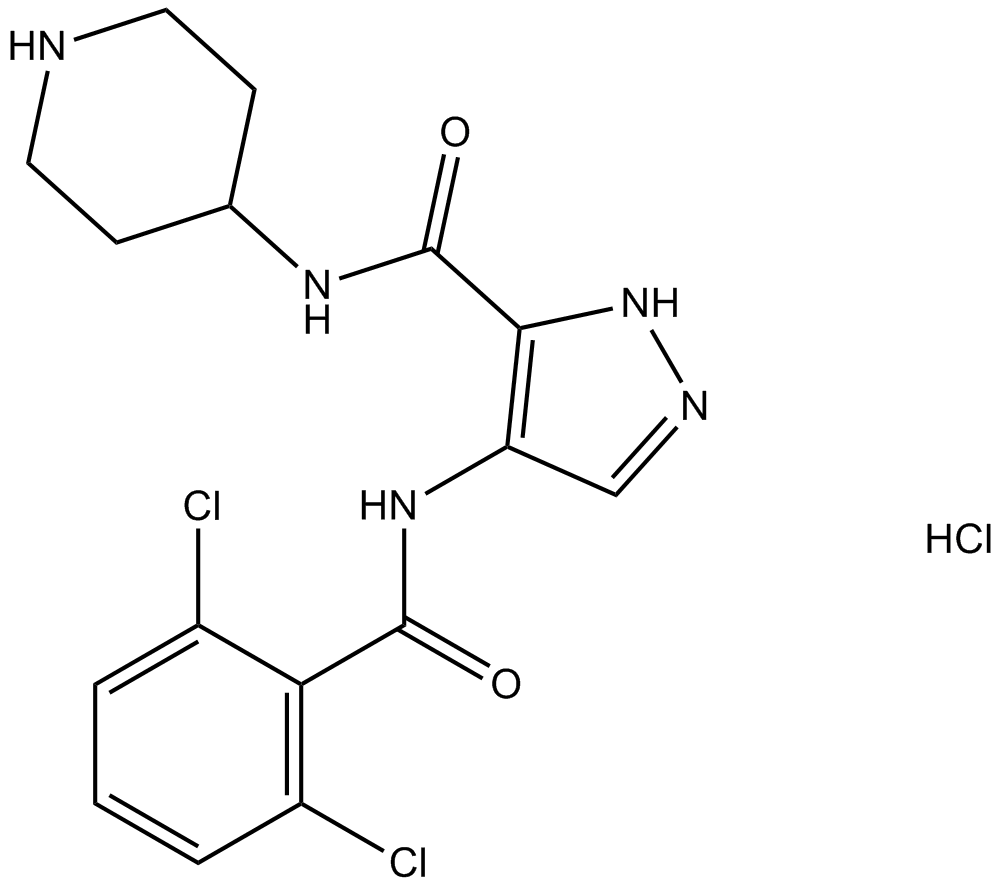AT7519 Hydrochloride |
| Catalog No.GC13998 |
A Cdk inhibitor
Products are for research use only. Not for human use. We do not sell to patients.

Cas No.: 902135-91-5
Sample solution is provided at 25 µL, 10mM.
IC50: AT7519 showed potent antiproliferative activity (40-940 nmol/L) in a panel of human tumor cell lines.
Cyclin-dependent kinases (CDK) play a central role in the growth, division, and death of eukaryotic cell. This crucial role in cell cycle progression and their deregulation in several human cancers make them attractive therapeutic oncology targets. Series of CDK inhibitors was developed, among which, AT7519 is in early-phase clinical development currently.
In vitro: AT7519 showed potent antiproliferative activity (40-940 nmol/L)in a panel of human tumor cells, and the mechanism of action was shown to be consistent with the inhibition of CDK1 and CDK2. Cell cycle arrest caused by AT7519 followed by apoptosis in human tumor cells and inhibited tumor growth in human tumor xenograft models [1].
In vivo: Tumor regression was observed following twice daily dosing of AT7519 in the HCT116 and HT29 colon cancer xenograft models. The authors show that these effects are linked to inhibition of CDKs in vivo and that AT7519 induces tumor cell apoptosis [1].
Clinical trial: A phase I pharmacokinetic and pharmacodynamic study of AT7519, a cyclin-dependent kinase inhibitor in patients with refractory solid tumors. Electrocardiogram review suggested a dose-dependent increase in QTc and recruitment was discontinued without establishing a maximum tolerated dose. 4 patients with stable disease for >6 months and one had a prolonged partial response. Pharmacokinetic profile indicated modest interpatient variation with linear exposure at increased doses. AT7519 elicited clinical and PD activity resulting from CDK inhibition at doses below the appearance of DLT of QTc prolongation [2].
References:
[1] Squires MS, Feltell RE, Wallis NG, Lewis EJ, Smith DM, Cross DM, Lyons JF, Thompson NT.Biological characterization of AT7519, a small-molecule inhibitor of cyclin-dependent kinases, in human tumor cell lines. Mol Cancer Ther. 2009;8(2):324-32.
[2] Mahadevan D, Plummer R, Squires MS, Rensvold D, Kurtin S, Pretzinger C, Dragovich T, Adams J, Lock V, Smith DM, Von Hoff D, Calvert H. A phase I pharmacokinetic and pharmacodynamic study of AT7519, a cyclin-dependent kinase inhibitor in patients with refractory solid tumors. Ann Oncol. 2011;22(9):2137-43.
Average Rating: 5 (Based on Reviews and 30 reference(s) in Google Scholar.)
GLPBIO products are for RESEARCH USE ONLY. Please make sure your review or question is research based.
Required fields are marked with *




















